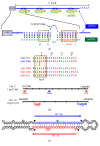Colorectal Cancer: From the Genetic Model to Posttranscriptional Regulation by Noncoding RNAs
- PMID: 28573140
- PMCID: PMC5442347
- DOI: 10.1155/2017/7354260
Colorectal Cancer: From the Genetic Model to Posttranscriptional Regulation by Noncoding RNAs
Abstract
Colorectal cancer is the third most common form of cancer in developed countries and, despite the improvements achieved in its treatment options, remains as one of the main causes of cancer-related death. In this review, we first focus on colorectal carcinogenesis and on the genetic and epigenetic alterations involved. In addition, noncoding RNAs have been shown to be important regulators of gene expression. We present a general overview of what is known about these molecules and their role and dysregulation in cancer, with a special focus on the biogenesis, characteristics, and function of microRNAs. These molecules are important regulators of carcinogenesis, progression, invasion, angiogenesis, and metastases in cancer, including colorectal cancer. For this reason, miRNAs can be used as potential biomarkers for diagnosis, prognosis, and efficacy of chemotherapeutic treatments, or even as therapeutic agents, or as targets by themselves. Thus, this review highlights the importance of miRNAs in the development, progression, diagnosis, and therapy of colorectal cancer and summarizes current therapeutic approaches for the treatment of colorectal cancer.
Figures





Similar articles
-
[SIGNIFICANCE OF NONCODING RNAS IN COLORECTAL CANCER: REVIEW].Nihon Geka Gakkai Zasshi. 2015 Nov;116(6):360-5. Nihon Geka Gakkai Zasshi. 2015. PMID: 26845887 Review. Japanese.
-
Noncoding RNA and colorectal cancer: its epigenetic role.J Hum Genet. 2017 Jan;62(1):41-47. doi: 10.1038/jhg.2016.66. Epub 2016 Jun 9. J Hum Genet. 2017. PMID: 27278790 Review.
-
Noncoding RNAs in the development, diagnosis, and prognosis of colorectal cancer.Transl Res. 2017 Mar;181:108-120. doi: 10.1016/j.trsl.2016.10.001. Epub 2016 Oct 14. Transl Res. 2017. PMID: 27810413 Review.
-
Noncoding RNAs and pancreatic cancer.World J Gastroenterol. 2016 Jan 14;22(2):801-14. doi: 10.3748/wjg.v22.i2.801. World J Gastroenterol. 2016. PMID: 26811626 Free PMC article. Review.
-
[Use of micro RNAs in the diagnosis and prognosis of colorectal cancer (CCR)].Gac Med Mex. 2016 May-Jun;152(3):386-96. Gac Med Mex. 2016. PMID: 27335196 Review. Spanish.
Cited by
-
miR‑448 targets Rab2B and is pivotal in the suppression of pancreatic cancer.Oncol Rep. 2018 Sep;40(3):1379-1389. doi: 10.3892/or.2018.6562. Epub 2018 Jul 12. Oncol Rep. 2018. PMID: 30015954 Free PMC article.
-
Circ_0056618 enhances PRRG4 expression by competitively binding to miR-411-5p to promote the malignant progression of colorectal cancer.Mol Cell Biochem. 2023 Mar;478(3):503-516. doi: 10.1007/s11010-022-04525-x. Epub 2022 Aug 2. Mol Cell Biochem. 2023. PMID: 35916967
-
Importance of Circ0009910 in colorectal cancer pathogenesis as a possible regulator of miR-145 and PEAK1.World J Surg Oncol. 2021 Sep 3;19(1):265. doi: 10.1186/s12957-021-02378-0. World J Surg Oncol. 2021. PMID: 34479583 Free PMC article.
-
Transmission Jeopardy of Adenomatosis Polyposis Coli and Methylenetetrahydrofolate Reductase in Colorectal Cancer.J Renin Angiotensin Aldosterone Syst. 2021 Dec 10;2021:7010706. doi: 10.1155/2021/7010706. eCollection 2021. J Renin Angiotensin Aldosterone Syst. 2021. PMID: 34956401 Free PMC article.
-
Two naturally derived small molecules disrupt the sineoculis homeobox homolog 1-eyes absent homolog 1 (SIX1-EYA1) interaction to inhibit colorectal cancer cell growth.Chin Med J (Engl). 2021 Sep 23;134(19):2340-2352. doi: 10.1097/CM9.0000000000001736. Chin Med J (Engl). 2021. PMID: 34561318 Free PMC article.
References
Publication types
MeSH terms
Substances
LinkOut - more resources
Full Text Sources
Other Literature Sources
Medical

